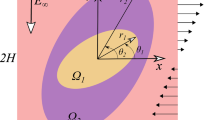Different methods for the numerical description of the behavior of a fluid–fluid interface in an electric field are proposed. A variation in the base system of equations for dielectrics and weakly conducting fluids is demonstrated. A deterministic approach to the description of two-phase flows traveling under the effect of an electric field is used. The system of equations proposed by G. A. Ostroumnov is adopted as a basis for a quantitative description of electrohydrodynamic phenomena. The proposed approach is used in numerical simulation of processes that occur in the intra-electrode space of electrodispersers and electrocoalescers in order to optimize their design and attain the maximal effect of separation with minimum energy costs.
Similar content being viewed by others
References
G. Taylor, “Disintegration of water drops in an electric field,” Proc. Roy. Soc. London. Series A. Math. Phys. Sci., 280, 383–397 (1964).
J. Sherwood, “Breakup of fluid droplets in electric and magnetic fields,” J. Fluid Mech., 188, 133–146 (1988).
D. M. Anderson, G. B. McFadden, and A. A. Wheeler, “Diffuse-interface methods in fluid mechanics,” Ann. Rev. Fluid Mech., 30, 139–165 (1998).
V. E. Badalassi, H. D. Ceniceros, and S. Banerjee, “Computation of multiphase systems with phase field models,” J. Comp. Phys., 190, 371–397 (2003).
J. Hua, L. K. Lim, and C. H. Wang, “Numerical simulation of deformation/motion of a droplet suspended in viscous fluids under influence of steady electric field,” Phys. of Fluids, 20. I, No. 11, 1–12 (2008).
G. Tomar, D. Gerlach, and G. Biswas, J. Comp. Phys., 227, 1267–1285 (2007).
S. O. Unverdi and G. Tryggvason, “A front-tracking method for viscous, incompressible, multi-fluid flows,” J. Comp. Phys., 100, 25–37 (1992).
A. Fernandez, G. Tryggvason, J. Che, and S. Cessio, “The effects of electrostatic forces on the distribution of drops in a channel flow: two dimensional oblate drops,” Phys. of Fluids, 17, 093302.1–093302.15 (2005).
S. Osher and R. Fedkiw, “Level set methods and dynamic implicit surfaces,” Appl. Math. Sci., 153, 3–16 (2003).
J. Zhang and D. Y. Kwok, “A 2D lattice Boltzmann study on electrohydrodynamic drop deformation with the leaky dielectric theory,” J. Comp. Phys., 206, 150–161 (2005).
G. A. Ostroumov, “On the hydrodynamics of electric charges,” Zh. Tekh. Fiz., 24, Iss. 10, 1915–1919 (1954).
O. Ghazian and K. Adamiak, “Castle numerical simulation of electrically deformed droplets less conductive than ambient fluid,” Colloids and Surf. A. Physicochem. Eng. Aspects, 423, 27–34 (2013).
J. R. Melcher and G. I. Taylor, “Electrohydrodynamics: A review of the role of interfacial shear stresses,” Ann. Rev. Fluid Mech., 1, 111–146 (1969).
K. V. Tarantsev and A. V. Korosteleva, “Optimization of design of ejector-type mixer for producing fuel emulsions in an electric field,” Chem. Petrol. Eng., 49, No. 3–4, 173–177 (2013).
K. V. Tarantsev, E. G. Krasnaya, V. A. Chirkov, and I. A. Ashikhmin, “Breakdown of water-oil emulsions in an electric field,” Chem. Petrol. Eng., 49, No. 7–8, 435–439 (2013).
K. V. Tarantsev, “Simulation of the processes of coagulation and dispersion of water in low-conductive fluids in an electric field,” Surf. Eng. Appl. Electrochem., 49, No. 5, 414–422 (2013).
K. V. Tarantsev, A. V. Korosteleva, and I. A. Proshin, “Development of design of electrodehydrator for dewatering water-oil emulsions by numerical methods using Salome software,” Chem. Petrol. Eng., 51, No. 5–6, 293–297 (2015).
K. V. Tarantsev and I. A. Proshin, “Development of a design for a mixer/electrocoalescing unit for production of water-in-oil emulsions by numerical methods,” Chem. Petrol. Eng., 51, No. 3–4, 233–236 (2015).
Author information
Authors and Affiliations
Corresponding author
Additional information
Translated from Khimicheskoe i Neftegazovoe Mashinostroenie, No. 12, pp. 8–10, December, 2016.
Rights and permissions
About this article
Cite this article
Tarantsev, K.V., Proshin, I.A. Foundations of Numerical Simulation and Design of Electrodynamic Devices for the Creation and Disintegration of Water-Oil Emulsions. Chem Petrol Eng 52, 810–814 (2017). https://doi.org/10.1007/s10556-017-0275-0
Published:
Issue Date:
DOI: https://doi.org/10.1007/s10556-017-0275-0



